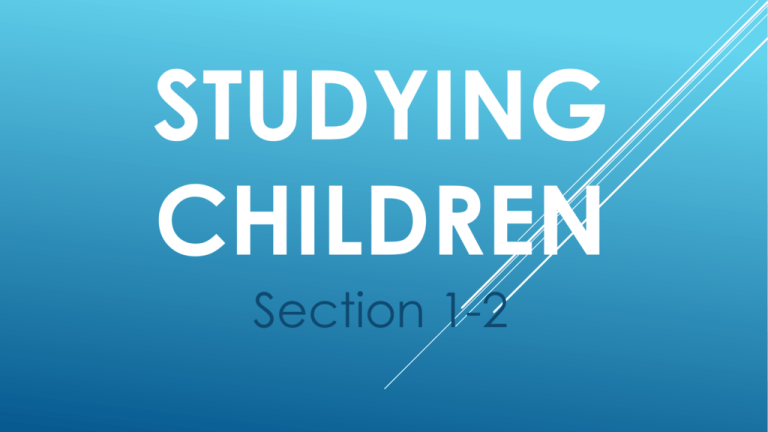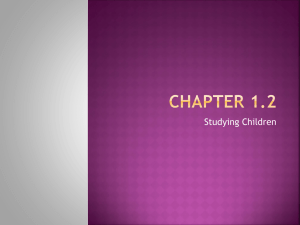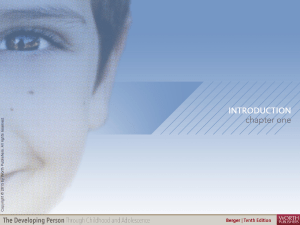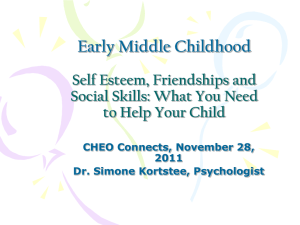1-2 Studying Children
advertisement

STUDYING CHILDREN Section 1-2 Why is childhood crucial? Childhood adulthood. is a time of preparation for Children’s brains not yet fully developed at birth- in fact, the brain is the least developed of all the organs. A baby’s brain is about ¼ the size of an adult’s. By age 3, it has produced hundreds of trillions of connections among the brain cells. Scientists have found that babies’ brains develop in response to stimulation, which includes activities that provoke a baby’s… sense of sight sense of sound sense of touch sense of taste sense of smell Stimulating activities can improve a baby’s curiosity, attention span, memory, and nervous system development. Stimulated babies also have a more secure self-image. Babies make connections with things that stimulate them, and as things are repeated it reinforces pathways in the brain, making it easier to repeat the action the next time. Stimulation also helps retain those connections. Theories About Development Child development theorists have provided valuable information about how children learn and develop skills. Some theorists perform experiments to test their theories. Other theories cannot be tested. Major Child Development Theorists Sigmund Jean Freud (1856-1939) Piaget (1896-1980) Lev Vygotsky (1896-1934) Erik Erikson (1902-1994) B. F. Skinner (1904-1990) Albert Urie Bandura (1925- ) Bronfenbrenner (1917-2005) Sigmund Freud (1856-1939) Believed that personality develops through a sense of stages. Experiences in childhood profoundly affect adult life. Significance: Childhood is much more important than previously thought, and its effects are longer lasting. Jean Piaget (1896-1980) The first to study children scientifically. Focused on how children learned. Believed that children go through four stages of learning. Significance: Children must be given learning tasks appropriate to their level of development. Lev Vygotsky (1896-1934) Wrote that biological development and cultural experience both influence children’s ability to learn. Believed social contact was essential to intellectual development. Significance: Children should be given the opportunity for frequent social interaction. Erik Erikson (1902-1994) Like Freud, said that personality develops in stages. Thought that each stage includes a unique psychological crisis. If that crisis is met in a positive way, the individual develops normally. Significance: Parents and other caregivers must be aware of, and sensitive to, children’s needs at each stage of development and support them through crises. B. F. Skinner (1904-1990) Argued that when a child’s actions have positive results, they will be repeated. Negative results will make the actions stop. Significance: Parents and other caregivers can affect a child’s behavior through the use of negative and positive feedback. Alfred Bandura (1925- ) Said that children learn by imitating others. Disagreed with Skinner. Pointed out that although the environment shapes behavior, behavior also affects environment. Significance: Caregivers must provide good examples for children to follow. Urie Bronfenbrenner (1917-2005) Outlined layers of environment that affect a child’s development, such as the child’s own biology, family/community environment, and society. Significance: Child’s primary relationship with a caregiver needs to be stable, loving, and lasting. Characteristics of Development 1) Development is similar for each individual. 2) Development builds upon earlier learning. 3) Development proceeds at an individual rate. 4) The different areas of development are interrelated. 5) Development is a lifelong process. Influences on Development • Children develop at different rates because each has a unique combination of factors influencing their development. • The factors fall into one of two categories: • Heredity • Environment Heredity • The biological transfer of certain characteristics from earlier generations. • Examples include: • Blood type • Eye color • Hair color • Height Environment • The people, places, and things that surround and influence a person. • Examples include: • Family • Home • School • Community Heredity Environment Nature vs. Nurture • Heredity is often referred to as nature. • Nurture is used to refer to influences and conditions in a child’s environment. • For years, scientists and philosophers have debated whether nature or nurture has more influence. • Most agree that they work together. • Children inherit certain physical characteristics from their parents and ancestors. • Children also learn attitudes and beliefs from their environment. • Children are greatly influences by the wider world around them. What they read, the music they listen to, the type of which community in which they grow up- all these and many other influences play a part in who they become. • Children don’t always copy the attitudes and actions of others, and no two children are exactly alike. They react to outside influences in their own ways. • Brothers and sisters who grow up in the same home may experience life differently, and they may become two different people. • No two children have exactly the same environment- even those who grow up in the same home. Their choice of friends, food, and activities will differ, and so will they. • During infancy and early childhood, environment plays a particularly important role in development. That is why working with young children is such an important responsibilityand such a challenging opportunity. Lifelong Growth and Development • Development doesn’t end when childhood does. It continues through life- from birth to death- in stages called the human life cycle. • Each stage of the cycle presents different developmental tasks (challenges that must be met or skills to be acquired). • Mastering the tasks of one stage prepares a person for the next. Development Beyond Childhood • Adolescence (between childhood and adulthood) • Young adulthood (people in their 20s) • The Thirties (people in their 30s) • Middle Age (ages 44 to 55) • Late adulthood (ages 55 to 75) • Very late adulthood (beyond age 75) Adolescence (between childhood and adulthood) During this time, teens work on three developmental tasks: • • creating an identity • becoming independent • pursuing education and career opportunities Young adulthood (people in their 20s) • Many young adults finish their education and begin working. • Many marry in this period. The Thirties (people in their 30s) • This stage presents the challenges of: • Establishing roots • Reevaluating life choices made earlier • Finding stability in career and relationships Middle Age (ages 44 to 55) • Parents adjust as their children become more independent • Adults in this stage typically ask themselves if they are satisfied with the life they have built. If not, they may make changes. Late adulthood (ages 55 to 75) • Most adults retire. • People may become more politically or socially active, travel, take classes, or enjoy other activities they didn’t have time for before. • Some people enjoy having time with their grandchildren. • Health issues may arise. Very late adulthood (beyond age 75) • Health problems become more common. • Many older adults are still active, and they contribute their knowledge and experience to society. • Older adults in fragile health may need more assistance or care. The Role of Self-Etseem in Development • Self-esteem, or self-worth, refers to the value people place on themselves. • Self-esteem plays a role in people’s ability to face and overcome the challenges of each developmental stage, including those of young childhood. • People with low self-esteem often feel that they are failing or constantly disappointing others. • Researchers have found a link between low self-esteem and poor school performance, truancy, and criminal behavior. • A sense of self-worth is critical to children’s development. • Research has shown that the level of self-esteem that is developed in childhood changes little over time. • Children who feel good about themselves are more likely to show enthusiasm for learning, form friendships, and make healthy choices. • Having a sense of self-worth can help children deal with life’s frustrations and disappointments as well as its successes. Chapter 1, Section 2 Review Questions 1) Explain why early childhood is considered the most important period for brain development. 2) What are the five characteristics of child development? 3) Compare the major theories of Erkison and Freud. How are they alike and different? 4) Explain what is meant by “nature” and “nurture”. Why do scientists believe they they work together to influence development? 5) Identify the six stages of adolescent and adult development, and choose one to explain in detail. 6) How can positive selfesteem help a child?








